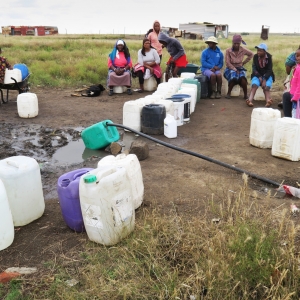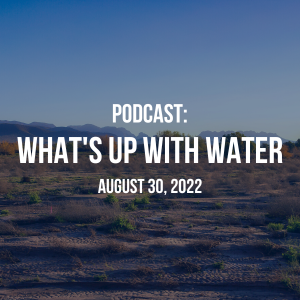Federal Water Tap, August 29: EPA Proposes Regulating Two PFAS Chemicals under Superfund Law
The Rundown
- The EPA proposal would designate two PFAS chemicals as hazardous substances.
- A USGS research team summarizes green infrastructure benefits and unintended consequences in the Great Lakes basin.
- EPA science advisers chime in on PFAS regulatory process for drinking water.
- The White House wants more information on natural capital accounting.
- Washington state officials release a final report on breaching four lower Snake River dams.
And lastly, lawyers for Rio Grande states continue to negotiate a water-dispute settlement.
“Despite how the health of nature drives the health of the economy, implementation of the national economic accounts is disconnected from our understanding of nature.” — Excerpt from the White House’s draft strategy on natural capital accounting.
By the Numbers
$10.3 Billion to $31.3 Billion: Estimated cost of replacing the benefits of four dams on the lower Snake River, if the dams were to be breached. That’s according to a report from the offices of Gov. Jay Inslee and Sen. Patty Murray, both Democrats from Washington state, where the dams have blocked salmon runs for decades. The report states that replacing the dams’ benefits — irrigation, hydropower, navigation, and recreation — is possible but at significant cost.
News Briefs
Accounting for Nature
The White House is requesting information that would help administration staff standardize methods for valuing, measuring, and tracking the benefits that the natural world provides to humans.
Called natural capital, these benefits range from the water-filtering capability of wetlands to the flower pollination conducted by bees. The natural capital accounts would stand next to producer-consumer measurements like gross domestic product as part of official U.S. economic statistics.
Along with the information request, the White House published a draft strategy for natural capital accounting.
Officials might consider a report published in July from an intergovernmental panel on ecosystems and biodiversity. The IPBES report found more than 50 accounting methods for nature’s value, many of which go beyond the concept of natural capital.
Comments are due by October 21, 2022. Submit them via www.regulations.gov using docket number OMB-2022-0009.
Proposal Would Bring Two PFAS Under Superfund Umbrella
The EPA proposed designating two “forever chemicals” — PFOA and PFOS — as hazardous substances under the federal Superfund law, a move that would provide a pathway for forcing cleanup of the chemicals and recovering the cost of doing so.
The action applies to five broad categories of industries, including wastewater utilities. The other categories are all PFAS producers, processors, or companies that make products containing PFAS.
The lobby group for the wastewater industry has appealed to Congress for an exemption from Superfund liability. Its argument is that wastewater utilities do not produce the contaminants. They are merely conduits, and ratepayers should not be saddled with cleanup costs.
Environmental advocates, meanwhile, are calling for the EPA to designate the entire class of PFAS – thousands of chemical compounds in total – as hazardous substances.
The agency will soon publish a notice of its proposal in the Federal Register, which will open a 60-day public comment period.
In context: Who Pays? PFAS Lawsuits, Legislation Raise Question of Legal Liability
Studies and Reports
PFAS Drinking Water Standards: A Science Review
The EPA Science Advisory Board submitted its final report assessing the agency’s scientific justifications for setting national drinking water standards for PFOA and PFOS.
The board supported many of the agency’s conclusions. But John Gardella, a lawyer who follows PFAS cases, noted that the board issued some red flags: a “lack of transparency, flawed data, inconsistent methodologies, and potentially unsound scientific foundations for some conclusions.”
The EPA plans to propose draft regulations for the two chemicals this fall and will incorporate the board’s findings.
Green Infrastructure Outcomes in the Great Lakes
How good is green?
A U.S. Geological Survey research team summarized the existing literature on the performance and hindrances of green infrastructure projects in the Great Lakes basin.
The number of such designs in the region is rapidly increasing though accounting for its benefits is incomplete and “poorly supported by empirical evidence,” the report noted.
Many projects aim to dampen urban flooding or trap contaminants. Many projects did so. However, there are always drawbacks. One of the biggest unintended consequences, the report found, is the potential for unwanted contaminants in stormwater to mix with local groundwater.
The report assessed outcomes from mostly leafy interventions: street swales, green roofs, urban trees, and porous pavement. It did not examine rainwater harvesting or detention basins.
On the Radar
Rio Grande Water Dispute Approaches Deadline
At a virtual hearing last week, the Supreme Court-appointed judge who is overseeing a Rio Grande water dispute ordered the parties to share draft settlement language by the end of next week, El Paso Matters reports.
The basin states have a September 23 deadline to produce an agreement or the case would move to trial before the nation’s high court.
“We continue to make progress,” said Lee Leininger of the U.S. Department of Justice, which is party to the lawsuit. “There’s choppy waters, but we are continuing the course.”
Texas sued New Mexico in 2013, claiming that groundwater extraction in New Mexico was siphoning water meant for Texas under the Rio Grande Compact, a water-sharing agreement signed in 1938.
Federal Water Tap is a weekly digest spotting trends in U.S. government water policy. To get more water news, follow Circle of Blue on Twitter and sign up for our newsletter.
Brett writes about agriculture, energy, infrastructure, and the politics and economics of water in the United States. He also writes the Federal Water Tap, Circle of Blue’s weekly digest of U.S. government water news. He is the winner of two Society of Environmental Journalists reporting awards, one of the top honors in American environmental journalism: first place for explanatory reporting for a series on septic system pollution in the United States(2016) and third place for beat reporting in a small market (2014). He received the Sierra Club’s Distinguished Service Award in 2018. Brett lives in Seattle, where he hikes the mountains and bakes pies. Contact Brett Walton







Leave a Reply
Want to join the discussion?Feel free to contribute!